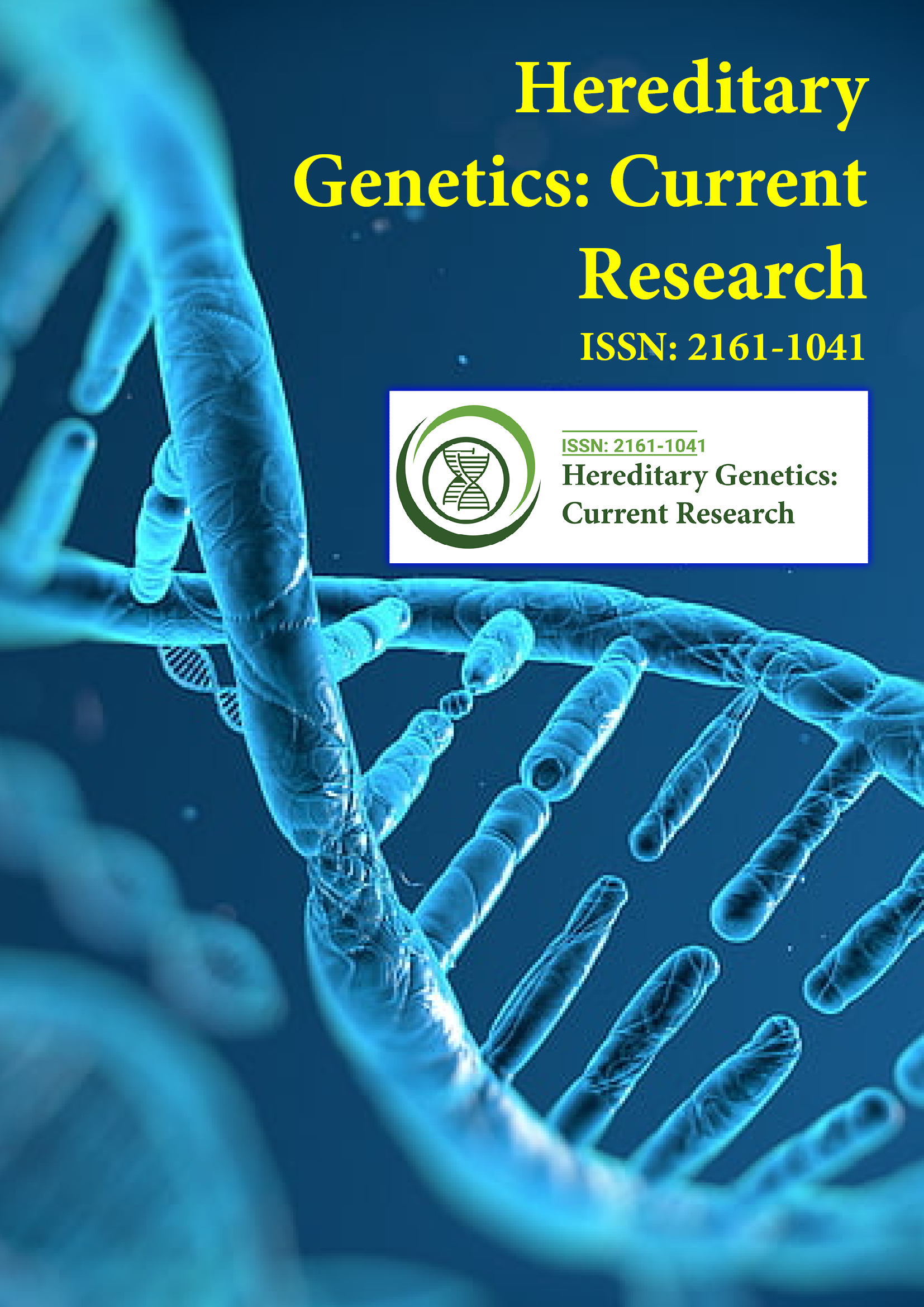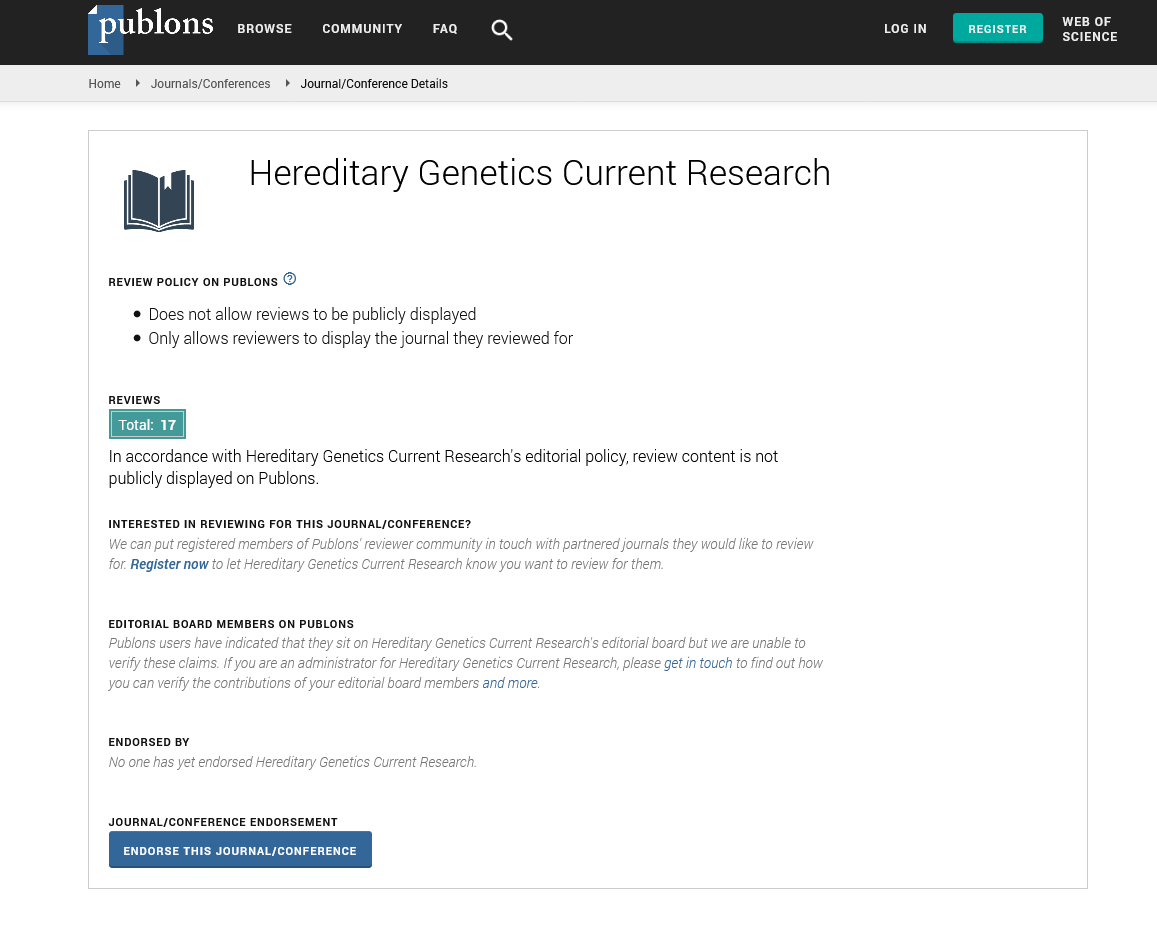PMC/PubMed Indexed Articles
Indexed In
- Open J Gate
- Genamics JournalSeek
- CiteFactor
- RefSeek
- Hamdard University
- EBSCO A-Z
- NSD - Norwegian Centre for Research Data
- OCLC- WorldCat
- Publons
- Geneva Foundation for Medical Education and Research
- Euro Pub
- Google Scholar
Useful Links
Share This Page
Journal Flyer

Open Access Journals
- Agri and Aquaculture
- Biochemistry
- Bioinformatics & Systems Biology
- Business & Management
- Chemistry
- Clinical Sciences
- Engineering
- Food & Nutrition
- General Science
- Genetics & Molecular Biology
- Immunology & Microbiology
- Medical Sciences
- Neuroscience & Psychology
- Nursing & Health Care
- Pharmaceutical Sciences
Articles published in Hereditary Genetics: Current Research have been cited by esteemed scholars and scientists all around the world. Hereditary Genetics: Current Research has got h-index 9, which means every article in Hereditary Genetics: Current Research has got 9 average citations.
Following are the list of articles that have cited the articles published in Hereditary Genetics: Current Research.
| 2024 | 2023 | 2022 | 2021 | 2020 | 2019 | 2018 | 2017 | 2016 | 2015 | 2014 | 2013 | 2012 | |
|---|---|---|---|---|---|---|---|---|---|---|---|---|---|
Total published articles |
10 | 41 | 30 | 10 | 11 | 2 | 6 | 16 | 20 | 27 | 20 | 27 | 17 |
Research, Review articles and Editorials |
0 | 2 | 0 | 1 | 1 | 2 | 6 | 13 | 14 | 12 | 12 | 16 | 12 |
Research communications, Review communications, Editorial communications, Case reports and Commentary |
10 | 39 | 30 | 9 | 10 | 0 | 0 | 3 | 6 | 15 | 8 | 11 | 5 |
Conference proceedings |
0 | 0 | 5 | 8 | 0 | 0 | 58 | 0 | 0 | 0 | 0 | 0 | 0 |
Citations received as per Google Scholar, other indexing platforms and portals |
18 | 33 | 84 | 62 | 43 | 38 | 47 | 48 | 90 | 28 | 17 | 11 | 2 |
| Journal total citations count | 534 |
| Journal impact factor | 1.42 |
| Journal 5 years impact factor | 2.34 |
| Journal cite score | 6.18 |
| Journal h-index | 9 |
Important citations
Formation and Resolution of Pial Microvascular Thrombosis in a Mouse Model of Thrombotic Thrombocytopenic Purpura
Reduced ADAMTS-13 level negatively correlates with inflammation factors in plasma of acute myeloid leukemia patients
Thrombotic Risks in Red Blood Cell Transfusions
Unconjugated bilirubin inhibits proteolytic cleavage of von Willebrand factor by ADAMTS13 protease
Tuning the endothelial response: differential release of exocytic cargos from Weibel-Palade bodies
Division of Laboratory Medicine, Department of Pathology, The University of Alabama at Birmingham, WP-P230K, 619 19th Street South, Birmingham, AL, 35249, USA
Deep intronic variant c.5999-277G>A of F8 gene may be a hot spot mutation for mild hemophilia A patients without mutation in exonic DNA
Variant effect on splicing regulatory elements, branchpoint usage, and pseudoexonization: Strategies to enhance bioinformatic prediction using hereditary cancer genes as exemplars
Splicing mutations in human genetic disorders: examples, detection, and confirmation
Hybridization Capture-Based Next-Generation Sequencing to Evaluate Coding Sequence and Deep Intronic Mutations in the NF1 Gene
Hybridization Capture-Based Next-Generation Sequencing to Evaluate Coding Sequence and Deep Intronic Mutations in the NF1 Gene
Hybridization Capture-Based Next-Generation Sequencing to Evaluate Coding Sequence and Deep Intronic Mutations in the NF1 Gene
Hybridization Capture-Based Next-Generation Sequencing to Evaluate Coding Sequence and Deep Intronic Mutations in the NF1 Gene
Hybridization Capture-Based Next-Generation Sequencing to Evaluate Coding Sequence and Deep Intronic Mutations in the NF1 Gene
Hybridization Capture-Based Next-Generation Sequencing to Evaluate Coding Sequence and Deep Intronic Mutations in the NF1 Gene
Hybridization Capture-Based Next-Generation Sequencing to Evaluate Coding Sequence and Deep Intronic Mutations in the NF1 Gene
Hybridization Capture-Based Next-Generation Sequencing to Evaluate Coding Sequence and Deep Intronic Mutations in the NF1 Gene
Hybridization Capture-Based Next-Generation Sequencing to Evaluate Coding Sequence and Deep Intronic Mutations in the NF1 Gene
Hybridization Capture-Based Next-Generation Sequencing to Evaluate Coding Sequence and Deep Intronic Mutations in the NF1 Gene
Hybridization Capture-Based Next-Generation Sequencing to Evaluate Coding Sequence and Deep Intronic Mutations in the NF1 Gene

